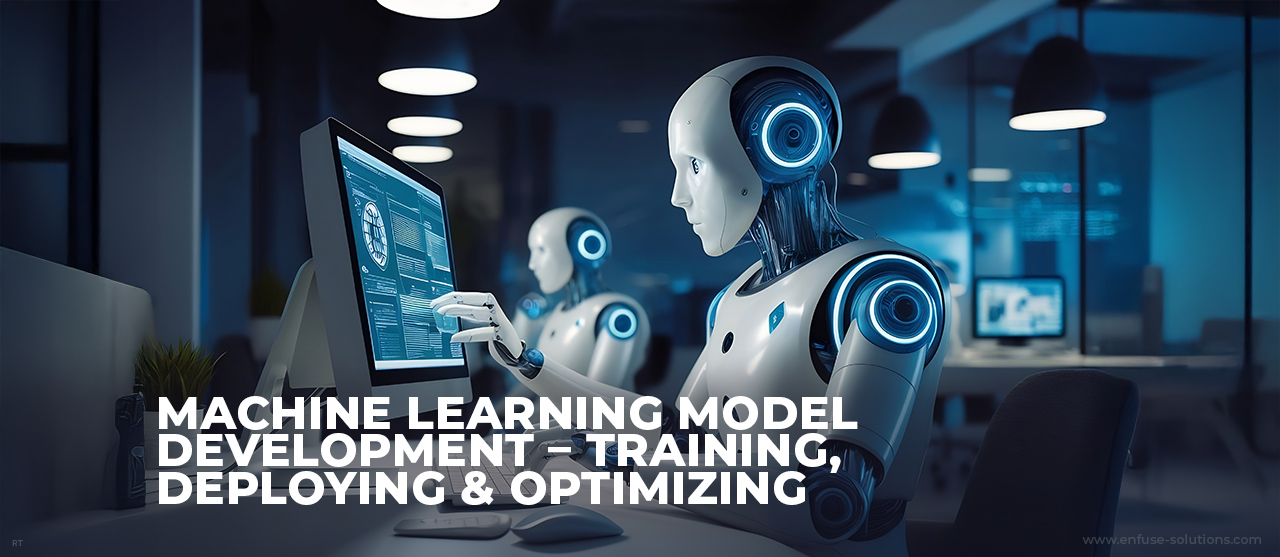
Machine learning (ML) is transforming industries by enabling automation, predictive analytics, and data-driven decision-making. However, developing ML models is a multi-stage process that requires strategic planning, robust deployment, and continuous optimization to ensure high performance and scalability.
According to MarketsandMarkets, the global machine learning market is projected to grow from $21.17 billion in 2022 to $209.91 billion by 2029, with a CAGR of 38.8%. This rapid growth underscores the need for efficient ML model development to stay ahead in the AI-driven business landscape.
Training ML Models: Laying The Foundation For AI Success
The training phase is where ML models learn from data to make accurate predictions. A well-trained model requires high-quality data, appropriate algorithms, and rigorous evaluation.
Key Steps in ML Model Training:
1. Data Collection & Preprocessing
- Studies show that 80% of AI project time is spent on data cleaning and preparation.
- Successful ML models rely on data augmentation, feature engineering, and handling imbalanced datasets.
2. Model Selection
- Decision Trees are widely used for structured data, while deep learning models (CNNs, LSTMs, Transformers) excel in complex tasks like image and natural language processing.
- AutoML tools like Google AutoML and H2O.ai can automate algorithm selection for efficiency.
3. Training & Evaluation
- Cross-validation, confusion matrices, and ROC curves help assess model accuracy.
- Hyperparameter tuning using Bayesian optimization improves model generalization.
Case Study: Google’s BERT model revolutionized natural language processing (NLP) by leveraging transformer-based architectures to improve search query understanding by 10% across all languages.
Deploying ML Models: Turning AI Into Real-World Solutions
Once trained, ML models need seamless deployment to handle real-time predictions, large-scale data processing, and continuous updates.
Key Aspects of ML Model Deployment:
1. Integration & APIs
- Cloud-based solutions like AWS Lambda, Azure ML, and Google Cloud AI allow serverless deployments for cost-effective scalability.
- API-first ML models ensure easy integration into existing business applications.
2. Scalability & Performance
- Edge AI is gaining traction, with AI models running directly on IoT devices (e.g., self-driving cars).
- Containerized ML deployments using Kubernetes & Docker enable efficient scaling.
3. Monitoring & Maintenance
- A study by Forbes reveals that 87% of ML models never make it to production due to poor monitoring and model drift.
- Tools like MLflow and Kubeflow help automate monitoring and retraining.
Case Study: Netflix uses ML deployment pipelines to recommend personalized content in real time, leading to a huge increase in user engagement.
Optimizing ML Models: Enhancing Speed, Accuracy & Efficiency
Optimizing ML models ensures better performance, faster inference, and lower computational costs.
Key ML Optimization Techniques:
1. Hyperparameter Tuning
- Automated Grid Search, Random Search, and Neural Architecture Search (NAS) help fine-tune ML models.
- Example: OpenAI improved GPT models by leveraging adaptive optimization techniques, reducing training time by 30%.
2. Model Pruning & Quantization
- Reducing model complexity while maintaining accuracy enhances performance.
- Example: MobileNet uses model pruning to optimize deep learning models for smartphones, reducing storage requirements by 75%.
3. Efficient Inference & Edge Computing
- Low-latency models deployed on IoT devices and self-driving cars ensure faster decision-making.
- Google’s Tensor Processing Units (TPUs) improved ML inference by 15x compared to traditional GPUs.
Case Study: Tesla’s Autopilot AI uses real-time inference on neural networks to process over a million miles of driving data daily, optimizing self-driving performance.
Continuous Improvement & Maintenance: Keeping ML Models Relevant
ML models need regular updates to maintain accuracy as data patterns evolve.
Best Practices for Continuous ML Model Improvement:
1. Automated Retraining Pipelines
- Uber’s Michelangelo AI automates model retraining, reducing model drift.
- Kubeflow Pipelines helps integrate CI/CD workflows for AI updates.
2. Data Monitoring & Adaptive Learning
- Real-time analytics using Apache Kafka enables dynamic model adjustments.
- Example: Fraud detection models in fintech continuously learn from new fraudulent patterns.
3. A/B Testing & Fairness Audits
- Ensuring AI fairness is crucial for ethical AI adoption.
- Facebook’s AI Bias Detection Framework helps eliminate algorithmic discrimination.
Case Study: Amazon’s Dynamic Pricing AI updates product prices based on real-time demand, increasing sales.
Conclusion: Driving Business Growth With Scalable ML Models
The ML lifecycle—from training and deployment to optimization and maintenance—requires cutting-edge strategies and automation. Organizations that leverage AI, cloud computing, and MLOps best practices can achieve the following:
- Faster model training & deployment
- Higher accuracy with efficient models
- Scalable AI applications for real-world impact
Ready to scale your AI initiatives? Stay ahead in the AI revolution with EnFuse Solutions by Investing in automated ML pipelines, cloud-based deployment, and AI-powered analytics.

















Comment